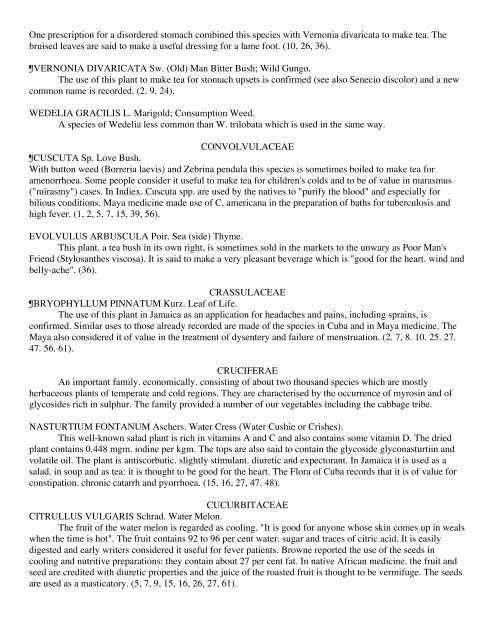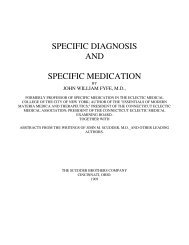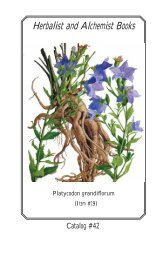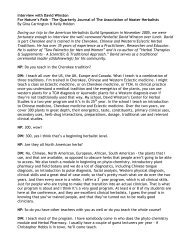MEDlCINAL PLANTS OF JAMAICA. PARTS 1 & 11.
MEDlCINAL PLANTS OF JAMAICA. PARTS 1 & 11.
MEDlCINAL PLANTS OF JAMAICA. PARTS 1 & 11.
You also want an ePaper? Increase the reach of your titles
YUMPU automatically turns print PDFs into web optimized ePapers that Google loves.
One prescription for a disordered stomach combined this species with Vernonia divaricata to make tea. The<br />
bruised leaves are said to make a useful dressing for a lame foot. (10, 26, 36).<br />
VERNONIA DIVARICATA Sw. (Old) Man Bitter Bush; Wild Gungo.<br />
The use of this plant to make tea for stomach upsets is confirmed (see also Senecio discolor) and a new<br />
common name is recorded. (2. 9. 24).<br />
WEDELIA GRACILIS L. Marigold; Consumption Weed.<br />
A species of Wedelia less common than W. trilobata which is used in the same way.<br />
CONVOLVULACEAE<br />
CUSCUTA Sp. Love Bush.<br />
With button weed (Borreria laevis) and Zebrina pendula this species is sometimes boiled to make tea for<br />
amenorrhoea. Some people consider it useful to make tea for children's colds and to be of value in marasmus<br />
("mirasmy") cases. In Indiex. Cuscuta spp. are used by the natives to "purify the blood" and especially for<br />
bilious conditions. Maya medicine made use of C. americana in the preparation of baths for tuberculosis and<br />
high fever. (1, 2, 5, 7, 15, 39, 56).<br />
EVOLVULUS ARBUSCULA Poir. Sea (side) Thyme.<br />
This plant. a tea bush in its own right, is sometimes sold in the markets to the unwary as Poor Man's<br />
Friend (Stylosanthes viscosa). It is said to make a very pleasant beverage which is "good for the heart. wind and<br />
belly-ache". (36).<br />
CRASSULACEAE<br />
BRYOPHYLLUM PINNATUM Kurz. Leaf of Life.<br />
The use of this plant in Jamaica as an application for headaches and pains, including sprains, is<br />
confirmed. Similar uses to those already recorded are made of the species in Cuba and in Maya medicine. The<br />
Maya also considered it of value in the treatment of dysentery and failure of menstruation. (2. 7, 8. 10. 25. 27.<br />
47. 56. 61).<br />
CRUCIFERAE<br />
An important family. economically. consisting of about two thousand species which are mostly<br />
herbaceous plants of temperate and cold regions. They are characterised by the occurrence of myrosin and of<br />
glycosides rich in sulphur. The family provided a number of our vegetables including the cabbage tribe.<br />
NASTURTIUM FONTANUM Aschers. Water Cress (Water Cushie or Crishes).<br />
This well-known salad plant is rich in vitamins A and C and also contains some vitamin D. The dried<br />
plant contains 0.448 mgm. iodine per kgm. The tops are also said to contain the glycoside glyconasturtiin and<br />
volatile oil. The plant is antiscorbutic. slightly stimulant. diuretic and expectorant. In Jamaica it is used as a<br />
salad. in soup and as tea: it is thought to be good for the heart. The Flora of Cuba records that it is of value for<br />
constipation. chronic catarrh and pyorrhoea. (15, 16, 27, 47. 48).<br />
CUCURBITACEAE<br />
CITRULLUS VULGARIS Schrad. Water Melon.<br />
The fruit of the water melon is regarded as cooling. "It is good for anyone whose skin comes up in weals<br />
when the time is hot". The fruit contains 92 to 96 per cent water. sugar and traces of citric acid. It is easily<br />
digested and early writers considered it useful for fever patients. Browne reported the use of the seeds in<br />
cooling and nutritive preparations: they contain about 27 per cent fat. In native African medicine. the fruit and<br />
seed are credited with diuretic properties and the juice of the roasted fruit is thought to be vermifuge. The seeds<br />
are used as a masticatory. (5, 7, 9, 15, 16, 26, 27, 61).







